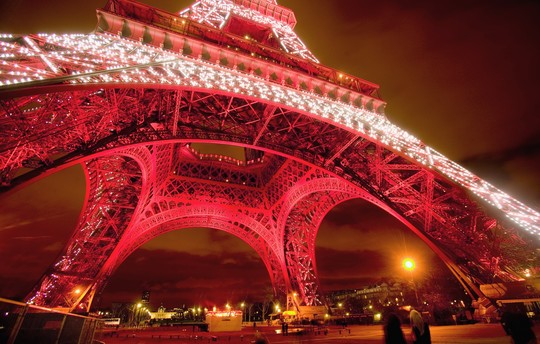Your Cart is Empty

With millions of second- or third-generation immigrants and more recent newcomers, France is a truly multicultural nation. Combined with the revival in regional and traditional culture, this allows for a particularly creative and exciting music scene.
Breton music draws on the common Celtic heritage of the Atlantic seaboard. The Breton pipe band comprises quintessential Breton instruments: the loud and raucous bombarde (shawm) and biniou (small Breton bagpipe), plus marching drums. Over the last thirty years, festoù-noz accompaniments have been supplanted by bands like Carré Manchot, who add fiddle, accordion, electric bass and drums.
Although it has its fair share of good rock bands like Red Cardell, the Breton scene has become incredibly eclectic. Jazz-oriented artists include the bombarde and saxophone player Roland Becker, who re-creates a unique jazz-circus music.
The former provinces of central France – Berry, Bourbonnais, Nivernais, Morvan, Limousin and Auvergne – form one of the strongholds of traditional music.
France claims a greater variety of bagpipes than any other country, the most notable being the grande cornemuse and cabrette from the old provinces of Berry and Bourbonnais, however, the region is also a stronghold of the hurdy-gurdy, with notable players including Gilles Chabenat and Pascal Lefeuvre. Masters of the bagpipes include Philippe Prieur, Eric Montbel and Frédéric Paris.
Known as Ile-de-France, dominating the country in more than one way, the Paris region has ten million inhabitants, many of them of provincial or foreign origin. The typical Parisian music of yesterday is not much in vogue anymore, though it inspires rock and folk artists such as François Hadji Lazaro, who launched Paris Combo and la Mano Negro.
Sometimes referred to as the “capital of world music”, Paris is a hotbed for all kinds of music, especially North African. Algerian icons Rachid Taha and Khaled live and work there, and the Orchestre National de Barbès took the country by storm in the early 2000s.
The Sephardic Jewish community’s best-known artist is the singer Enrico Macias, yet the Klezmer music scene is also very much alive, with Yom, the undisputed king of klezmer clarinet and groups such as Klezmer Nova.
The Black African musical scene is very rich, with hundreds of first- or second-generation musicians from former colonies – Mali, Senegal, Ivory Coast, Congo, Benin, Madagascar and Gabon (Pierre Akendengué), but also Zaïre, Cape Verde, Nigeria (Keziah Jones, Tony Allen), Angola (Bonga) and Uganda (Geoffrey Oryema).
From Argentina came bandoneon grand master Juan José Masolini and Eduardo Makaroff (co-founder of the Gotan Project) and his friend Juan-Carlos Cacérès.
Relatively new to France, the Asian scene is best represented by the Vietnamese guitarist Nguyên Lê. Also Paris-based are two of the most renowned Baul singers from Bengal, Paban Das Baul and Senses bandleader Bapi Das Baul. Rajasthan’s singer and dancer Gulabi Sapera long toured and recorded with the world-class guitarist Thierry Titi Robin.
The swing manouche style invented by Django Reinhardt found a new life, guitar players are now invited into the fancy jazz clubs of the capital and more and more “gadgé” musicians espouse the genre, such as guitar player Thomas Dutronc. There is also a new and very successful electronica/swing band called Caravan Palace.
Very hard to classify are France’s biggest world star Manu Chao, accordionist Marc Perrone, guitarist Mad Sheer Khan and the veteran ensemble extraordinaire Hadouk Trio. Then there’s the warm and very danceable music of Lo’ Jo, led by Denis Péan, who helped the Tuareg group Tinariwen debut and launch their celebrated “Festival au Desert” near Timbuktu.
Roughly the southern half of France, also known as “le Midi,” this is the linguistic area where the dying Occitan language found new life during the 1970s thanks to folk singers Rosina de Peira and Patric. The typical Provençal sound is that of a duo with fifre (fife) and drum, or from ensembles of galoubets-tambourins, three-holed pipes. But since the folk revival, virtuosos like André Gabriel and Miqueu Montanaro have enlarged the instrumentation and repertoire.
The Languedoc has some strange local instruments: traditional oboes often played alongside the bodega, the local bagpipe. Laurent Audemard was the inspirational figure behind the group Une Anche Passe, which has combined a love of Languedoc-style oboes with related instruments from elsewhere.
Roussillon is French Catalonia, whose capital is Perpignan. On both sides of the border, the national dance is the sardana, usually played by brass and wind bands or cobles, by traditional ensembles, such as La Cobla de Joglars.
Five thousand people strong, the largest Gypsy community of Western Europe is to be found in Perpignan. They mostly play rumba catalane, a mix of flamenco and Cuban rumba, as do Tekameli and Kaloomé. More Gitanos live in Arles, like the veteran guitarist Ricardo Baliardo, who became one of the first world music stars and is the father of Jacques, Maurice and Tonino Baliardo of the Gipsy Kings.
In the Alpes Maritimes area there is a choral tradition that spills over into Italy, with the group Corou de Berra and La Compagnie Vocale. Further north, Patrick Mazellier and Rigodon Sauvage have revived the violin tradition and the rigaudon dance. Grenoble, the main city of the Alps, is home to MusTraDem, a collective including the groups Dédale and Djal.